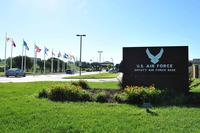For more football podcasts and articles, visit the Yards and Stripes Page on Military.com.
Every sports fan has a bucket list. If you’ve never been to an Army-Navy Game and it’s NOT on your list, you might as well tear the list up.
America’s Game sits alone on a sports rivalry pedestal, apart from all the usual suspects. It’s the most unique, special and majestic athletic spectacle in any given sports calendar year.
I never understood why or what makes it so special until my very first experience in 2000. I was working in the sports information office at the United States Naval Academy and the football season had been a struggle for both Army and Navy.
Army entered the game 1-9, while the Mids stood winless at 0-10. You couldn’t escape the school spirit all across the Yard in Annapolis beginning Monday the week of the game. Statues were painted. Exchange students pulled daily pranks. And of course “Go Navy, Beat Army” could be heard from sun up to sun down.
But why the hype and excitement for a game with both teams combing for just a single win during the 2000 season?
I didn’t “get it” until the morning of Saturday, December 2, 2000. Arriving at then PSINet Stadium in Baltimore, I was awestruck by all the military vehicles and hardware outside the gates. Military brass clad in dark uniforms from most every branch of service.
Inside the hype was building. Media began arriving mid-morning, well before the scheduled 3:00 p.m. kickoff on CBS. The march on for the Long Grey Line started at 12 noon, while the Brigade of Midshipmen came in together, company by company just 30 minutes later. In unison, both the Corps and Brigade saluted the crowd and everyone in attendance.
After both teams warmed up, there were flyovers with helicopters and fighter jets. Parachute teams from the Army and Navy entered the stadium with the American flag and the official game ball to a roaring crowd, freezing on a sunny afternoon in downtown Baltimore where temperatures struggled to hit 20 degrees all day.
Cheers went back and forth between the grey-clad Corps of Cadets and dark dress uniforms of the Brigade.
What other college football game or sporting event of any kind could feature the entire student body of one school in one corner and the entire student body of the opposing team in the other corner?
None.
You’ve all heard or read about the “best” rivalries in college football. Everyones has an opinion. Alabama-Auburn, Ohio State-Michigan, Florida-Florida State, Texas-Oklahoma, Georgia-Florida, BYU-Utah.
The list goes on of intense gridiron clashes, filled with passion, loyalty, disdain and unfortunately downright bitterness for the opposition.
What’s different about the Army-Navy Game is everything I described above and the fact it’s all lacking in every rivalry elsewhere.
However, the most striking difference is the sense of optimism the annual showdown between these two prestigious and distinguished service academies in Philadelphia, New York or sometimes Baltimore displays.
Army and Navy graduates watch it with pride. Family members with service ties to either branch watch it with lukewarm rooting interest for a particular side. General sports fans and diehards tune in, hoping for a good, close game and to soak in all of the pageantry.
The mission for four quarters is to play hard enough to earn the right to “sing second.” The losing team’s alma mater is played first followed by the victors. Besides when both teams roar out of the tunnel before a nationally-televised audience, the postgame singing of the alma maters is the other without-fail, hair-raising moment of the day.
Because no matter the outcome, every single person in the stands, watching at home or tuned in to the broadcast while serving in uniform around the globe, know our country and our nation’s freedom is in good hands. It’s thanks to the future officers who just went toe-to-toe leaving every ounce of blood, sweat, tears, passion and might on the field and often times visibly displayed on their stained jerseys and emotional postgame faces.
It’s an American moment. It’s an American event. And it’s a display of American exceptionalism.
Thank goodness we’re on the cusp of it again tomorrow. I can’t wait.














